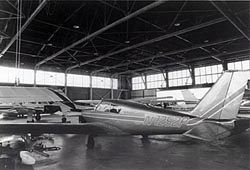
The Southwestern Proving Ground (SWPG) Airport Historic District in Hope, Arkansas, was utilized during World War II as an airfield for bombers and a testing ground for artillery shells and air bombs. The proving ground was in operation from 1941 to 1945 and was a major employer of Hempstead, Howard, Nevada, Clark and Lafayette counties. The construction of the Southwestern Proving Ground was part of the U.S. Government's National Defense Program which provided factories for the manufacture of munitions, airplanes and tanks in preparation for an eventual war. The news of construction on a proving ground in Hope became official in June of 1941. The Real Estate Department of the War Department was in charge of acquiring land by filing condemnation proceedings against the tract and then taking possession of those sections they required to begin immediate work. After the initial evacuation order the War Department decided they needed more room for an airport so they added more acres. In the end 404 families were relocated by a deadline of July 24th. Callahan Construction Company was awarded the job of erecting the proving ground by the War Department and the hiring of 4,000 construction workers began July 15th. Senator Spencer and the project director, W.K. Mellyor, agreed upon a guarantee of preferential treatment of local citizens in considerations for jobs.
When the airport was completed it had the third longest runway in the United States. Opening day festivities were postponed because of the bombing of Pearl Harbor on December 7th, 1941. Testing began in January 1942 and Hempstead County residents were finally allowed within the gates of the proving ground in April. Troops explored the capabilities of LaBolenge chronographs and solenoid chronographs (two different instruments that record time intervals) for accuracy and reliability. 105-mm shells that had fired prematurely in battle were determined by research at SWPG to have faulty rotating bands, thus saving the lives of American troops. B-25s were sent from the airport in Hope to the Gulf of Mexico to observe the testing of bombs for tumbling and proper ballistics after being fired. After World War II the city of Hope received the Southwestern Proving Ground Airport, which became Hope Municipal Airport in 1947.

The Southwestern Proving Ground Airport Historic District is composed of six buildings and five structures, which include the hangar, night landing plant, heating plant, storage building, garage, bomb assembly building, high explosives magazine and concrete runways and hangar apron. The magazine and bomb assembly building are located on adjacent land under private ownership. The remaining five buildings are located on 750 acres owned by Hope Municipal Airport. The hangar is located to the west of U.S. Highway 278 and is surrounded by a concrete apron on all sides. The building is constructed of brick in a restrained Art Deco style on a continuous concrete foundation with a barrel vaulted roof and four corner towers. The interior of the hangar covers a total of 25,000 square feet. The night landing plant is adjacent to the hangar and is about 40 feet from its southeastern corner. The plant is a very simple one-story rectangular brick edifice with a flat roof. The steam heating plant is located east of the hangar, across Airport Road. During the operation of SWPG this building generated steam heat to warm the buildings in the entire complex. The plant is currently empty but the city hopes to install a small museum dedicated to the history of the Proving Ground in the building at a future date. The storage building to the south of the steam heating plant is a rectangular vernacular building with a gable roof. The bomb assembly building is southwest of the hangar and is located on private property within a chain link fence. Bombs were assembled in this building and hauled by truck to Lake Charles, Louisiana, for testing. The high explosives building is located on private property and is south of the bomb assembly building, outside of the fenced in area.
Visit the National Park Service Travel American Aviation to learn more about Aviation related Historic Sites.
Last updated: August 29, 2017
